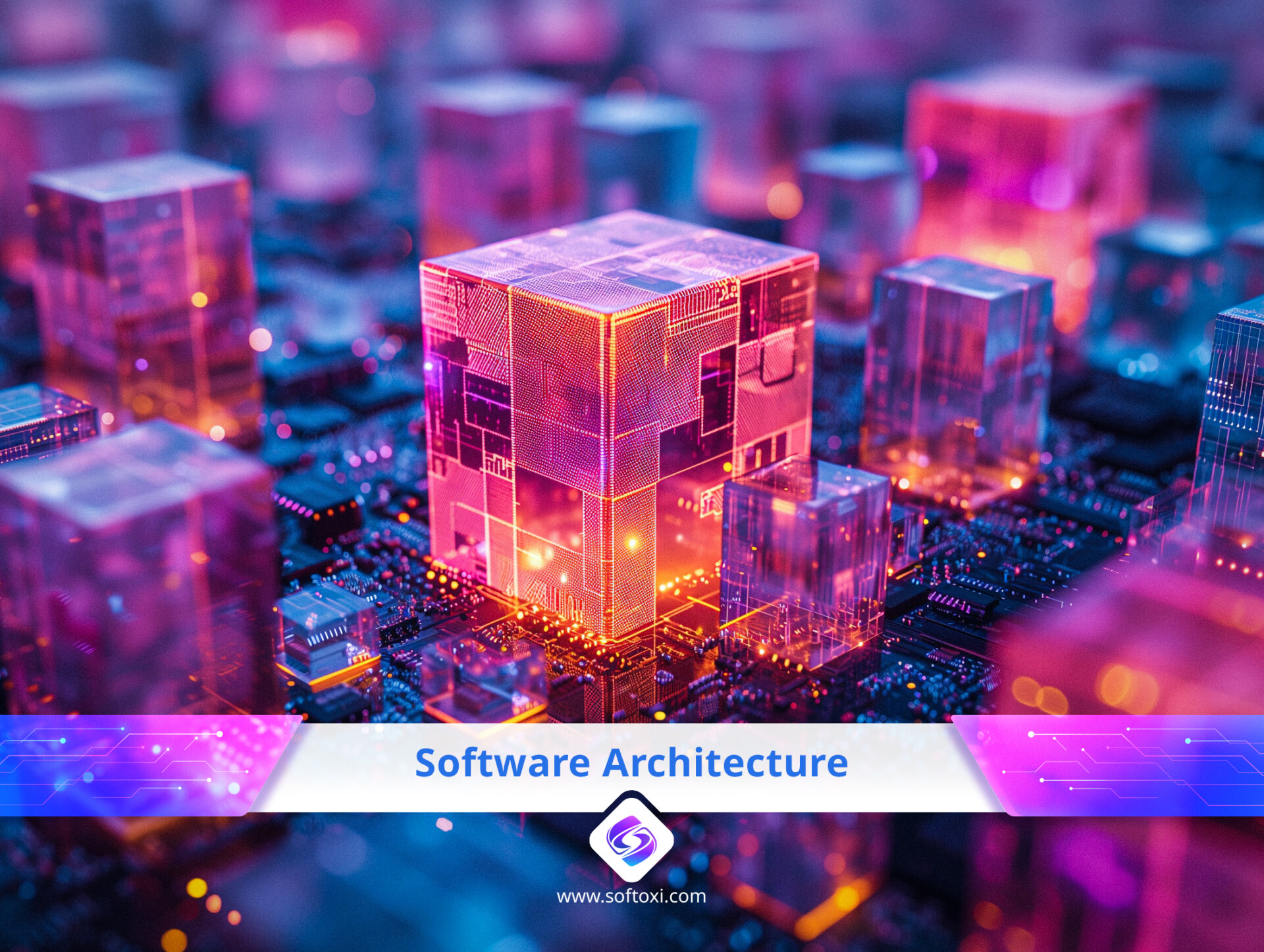Software architecture is the underlying frame of all your applications. It also determines the capabilities and performance of applications, ranging from banking to social media.
In this article, we’ll discuss software architecture and its principles, patterns, benefits, challenges, and emerging trends.
What Is Software Architecture?
Software architecture is a set of systems or structures required to create a software application. Every system consists of components linked to each other. These components are a part of the system’s infrastructure that supports the application.
Often, the architectural components are confused with application design, which is the design elements of the application itself. These design elements change with the application, but the architectural components can be reused across applications. Knowing this difference reduces changes or iterations during the architecture creation process.
Moreover, changing the architecture after implementation can be costly for your organization. Hence, you must understand the principles that shape the architecture for an efficient and scalable design.
7 Key Principles of Software Architecture
Before starting a software architecture design, understand the requirements and capabilities of the applications it supports. Also, see the architecture of the software from the perspectives of different stakeholders like application developers, investors, and users.
More importantly, know the seven key principles involved.
Modularity
Modularity is a key principle, and it means that any software architecture design must be a set of modules that interact with each other. Here, each module must handle a single specific task or function independently and, at the same time, must work together with other modules. Such a modular architecture makes it easy to maintain applications and promotes reuse.
Scalability
Closely associated with modularity is the principle of scalability. A modular architecture makes it easy to create new modules or remove existing ones to respond to a changing workload. Also, this principle enables you to allocate resources when needed, making it more cost-effective and efficient.
Abstraction
Abstraction is the process of hiding the architecture and its implementation from users. This concept enhances the usability of applications because users are concerned only about what the application does for them. They don’t have to know the underlying systems or the architecture type. Software architects use different mechanisms like interfaces and classes to achieve this abstraction.
Reliability
The reliability principle ensures that an architecture consistently performs its expected actions over a defined period. More importantly, the architecture must be available for users when they access an application. Also, the architecture must recover quickly from an interruption or failure.
Compatibility
The architectural software you design must be compatible with other systems to support easy data exchange. This principle is necessary to ensure that data can flow seamlessly between devices to provide the desired output for users. Also, it must coexist in the same space with other applications without creating any negative impact.
Testability
Testing is essential to ensure the reliability of your architecture and the application it supports. This is why your architecture must be easy to test. Also, when the architecture is testable, it increases collaboration between architects, developers, and testers.
Security
Security is another important attribute, as it must protect the application and its data from cyberattacks. It must include many sub-modules, including user authorization, confidentiality, and data integrity.
Thus, these are the principles that every software architecture must have. With these principles, you can create different architectural patterns to suit your specific needs.
7 Software Architecture Patterns
You can arrange the software components of your architecture in different ways to suit your specific needs. The way you organize them and make them work together is called an architecture pattern. Many patterns have been tested in the past, and the results show that specific patterns help in solving certain problems effectively.
Below are some common patterns:
Microservices
Microservices is an emerging pattern that is seeing wide adoption today. In this pattern, there’s a collection of services where each can be deployed independently. Also, each service is loosely coupled with other services. The advantage of this architecture is its modularity, as you can use it to create large and complex applications.
This architecture is well-suited for frequent software delivery in a complex and ambiguous business environment.
Layered Pattern
In this pattern, the components are organized into different layers based on their subtasks and objectives. Each layer is responsible for a specific function, and it depends on its previous and subsequent layers for overall execution. Here, each layer must be independent, so you can make changes to one layer without impacting the others.
This layered pattern is the most common architecture and is often called the “N-tier architecture.” It is well-suited for online e-commerce applications.
Client-Server
The client-server architecture is another popular pattern. It consists of two entities: a client and a server. In this setup, the server has all the resources, including website data, files, and services. On the other hand, the client is the application that interfaces with the user.
Based on the user’s demand and preference, the client will send a request to the server. In turn, the server will authenticate the client, process the request, and send the requested resources back to the client. Most web-based and file-sharing applications follow this pattern.
Monolithic
A monolithic architecture is deployed as a single application. Although this pattern does not support scalability and modularity, it enhances interactions and minimizes coupling. Also, it supports localization and increases the overall application performance and efficiency. However, software maintenance with this architecture is difficult.
Event-driven
In an event-driven architecture, events trigger the services or operations of applications. An event is often user-generated and can change the state of the application. Accordingly, the architecture and the application will respond to the event. A good example is when you fill out an online form and click the submit button. This event triggers a change, prompting the application to take a related action accordingly.
Cloud-native
As the name suggests, this architecture is optimized for the cloud. Today, cloud platforms offer high levels of resilience and fault tolerance because they are modular and easily deployable. The underlying architecture must support these requirements, as they help a business respond quickly to changing needs.
Serverless
Another upcoming architectural pattern is serverless architecture. In a serverless architecture, there are no servers, and the code executes in response to events. Also, in this pattern, the cloud provider handles the management and maintenance of the infrastructure while the developer is responsible for coding the responses. It is similar to event-driven architecture, except that the code responds.
These are some well-known architectural patterns. But which of these will be the future? Let’s look at some emerging trends.
Emerging Trends
Software architecture has to keep pace with the changes in the software and application world. Given the evolving technological landscape, you must be on top of the emerging trends to know how best to leverage them. Here’s a look at some trends in architecture software.
Edge Computing
The growing importance of the Internet of Things (IoT) has fueled the demand for edge computing. In particular, edge computing helps in distributed environments where enterprise applications are close to the source of data generation, which is the IoT sensors. This proximity between sources and applications improves response time and helps businesses gain deeper insights quickly. However, this emergence of edge computing requires a distributed architecture to encompass all end devices, regardless of how far they are from a central component.
Artificial Intelligence (AI)
AI, one of the most transformative technologies of this decade, also impacts software architecture definition. To start with, you can use AI to brainstorm and conceptualize ideas for the architecture. It can use advanced algorithms to identify the most precise architecture pattern based on the software types and features. Moreover, it can test, identify, and fix issues more efficiently. Due to its ability to impact every aspect of software design, it is a trend you must look out for.
Blockchain
Blockchain is another revolutionary technology. It is a distributed ledger with blocks as its nodes. Each block is connected to the previous and the subsequent block to form a chain, hence its name. These blocks are connected by cryptographic algorithms that protect your data and maintain its integrity. Each node holds consistent data that can support collaboration and communication within applications.
As more companies turn to this technology due to its positive impact on data security and integrity, it can lead to a decentralized architecture that connects millions of computers worldwide.
5G Connectivity
5G is the next generation of connectivity that can offer unparalleled transmission speeds to enhance user experience. Also, it can support thousands of applications for individuals and businesses as they can handle exponentially greater load levels. To take advantage of this trend, create an architecture to support countless applications.
Overall, technological advancements fuel the need for new and more powerful software architectures. Software architects need to create cutting-edge architecture modifications to support these trends.
7 Benefits of Software Architecture
The earlier discussion on the trends leads to this question, “Why should your organization invest in a stable architecture that can leverage emerging technologies?” The simple answer is that software architecture is the foundation for your applications and can offer many benefits. Below are some key benefits of software architecture.
Cost Savings
Cost savings is one of the biggest advantages of having a well-planned architecture. When you implement the key principles, you can save on software maintenance, downtime due to failures, unwanted and unused software licenses, and fines due to non-compliance with regulations.
Making the Most of New Opportunities
When new opportunities emerge, you need the right software architecture to leverage them quickly. This requires a modular and scalable architecture that can be quickly customized, depending on the opportunities. Without the right architecture, you may miss out on these opportunities.
Improved User Experience
The last few years have seen a heightened level of focus on user experience, and this has become a key aspect in becoming more competitive. To make your applications faster and more reliable, you need an architecture that’s conducive to your application and its features.
Reduces Development Time and Effort
Ideally, your software architecture should reduce the time for development, testing, and error fixing. If you can use your architecture to reduce development cycles and the time to market, you can gain higher revenues.
Prioritizes Your Goals
With the right programming architecture, you can prioritize your conflicting goals. In particular, this is important if many stakeholders are involved in the development and decision-making processes. You can also communicate the rationale behind your design decisions to stakeholders to enhance collaboration.
Mitigates Risks
With a well-developed software architecture, you reduce the chances of an application crash or failure. Also, a suitable architecture can reduce cyberattack possibilities and the financial and reputational loss that comes with it. Hence, the right software architecture can mitigate risks for your organization.
Introducing New Features
When it’s time to add new features, all that you have to do is add new modules or components to the architecture. This reduces the development time and the associated costs. Such a modular approach also eases code maintainability.
Despite these advantages, there are some challenges to watch out for.
5 Challenges to Watch Out
Creating a software architecture requires planning and a clear approach. And you must watch out for these challenges.
Security
Security is one of the biggest concerns today as software architectures are becoming more complex. A modular approach also increases the number of components and interactions, leading to more monitoring points.
To overcome this challenge, conduct regular security audits of your architecture. Make sure the design is thoroughly tested and evaluated before implementation. Also, focus on data security and privacy and include modules and processes to safeguard them.
Legacy System Integration
Many organizations today still have legacy systems, and they are likely to follow a monolithic architecture. To keep pace with evolving technologies, you must take a modular approach. Such diverse architectures can create a potential conflict, making it difficult to seamlessly integrate legacy systems into your current architecture.
One way to address this challenge is to implement integration in phases. This approach can minimize disruptions and create a fallback mechanism if something goes wrong. At the same time, make sure to take regular backups and plan for the continued maintenance of legacy systems.
Evolving Technology Stack
Technology is evolving rapidly, and keeping up with it can require resources. Also, if you have legacy systems, they can impede the quick adoption of new technologies. However, not migrating can lead to obsolescence, and you may not be able to offer advanced features to your end users.
Establish a continuous learning process and provide regular employee training to help them stay on top of emerging trends. Also, develop migration plans for outdated technologies to reduce costs and failures.
Cross-functional Collaboration
Cross-functional collaboration is challenging, especially if your organization is large and diverse. Bringing all stakeholders on the same page with decisions requires regular communication and good leadership.
Conduct regular meetings and fun activities to help members develop a cross-functional team bond. It can also help to establish mentorship programs.
Regulatory Compliance
Regulatory compliance is another dynamic aspect of today’s business environment. To cope with emerging technologies, governments continuously introduce new legislation, requiring organizations to implement updates to meet them. This updating process is time-consuming, expensive, and, in some cases, limiting to operations.
Stay on top of changing regulations and plan accordingly.
Overall, navigating these challenges is key, and one way to avoid them is to follow a set of best practices while creating a software architecture.
Best Practices for Software Architecture
Implementing best practices can reduce challenges and enable you to enjoy the benefits of a streamlined software architecture. Here are some aspects to consider:
Set Clear Goals
The first step is to set clear goals. Know what you want the architecture to do and ensure that it aligns with your organization’s vision and mission. Consider brainstorming sessions with stakeholders to identify the architecture type.
Evaluate the Current State
A lack of understanding of the current system can lead to a poor design, especially if you have legacy systems and components. Start with a thorough evaluation of your current tech stack and infrastructure and assess the required changes. Consider using appropriate tools and technologies to help through this assessment process.
Use Graphics
The adage, “A picture speaks a thousand words,” is true for the business world, too. When you represent your findings about the gaps in your system and the need for a new architecture, along with the potential benefits of this shift in a graphical format, you’re more likely to reduce resistance to change. Use diagrams, charts, and flowcharts to explain the architecture to relevant stakeholders.
Documentation
Documentation is often an overlooked aspect of implementing software architecture. A lack of documentation hinders new employees from understanding the architecture and its rationale. Along with explaining the architecture, proper documentation will show why certain decisions were made. Such an approach can help with business continuity.
Continuous Integration and Continuous Deployment (CI/CD)
Consider implementing a CI/CD pipeline for automated testing of the architecture at different stages of implementation. This regular testing will help identify errors, and you can make the necessary changes before they impact the application’s performance.
Following these best practices can help create an efficient software architecture that will eventually boost the performance and reliability of applications.
Conclusion: Focus on the Current With an Eye on the Future
Software architecture is the foundation for your applications and can determine their performance, availability, and usability. In this article, we looked at the key principles and the best practices you can follow to create the right architecture that best meets your needs. Understanding the benefits can ensure that you devote the required time and resources, while seeing the challenges beforehand can steer you away from the roadblocks.
Knowing the emerging trends can make you look to the future and create applications that leverage new technologies to give your end users a technology-first experience. Such measures are also sure to boost your organization’s reputation and profitability.




